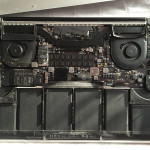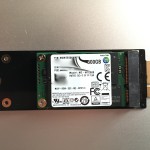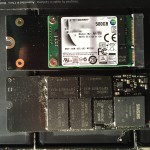Long-time Retina MacBook Pro owners finally have some reasonable storage upgrade options. Apple has used proprietary SSD form-factors and connectors for their thin notebooks since the second generation MacBook Air was released, but they’ve always used standard storage protocols, like SATA.
I’ve long hoped that someone would come out with a simple, inexpensive adapter that would allow a commodity mSATA or m.2 SSD in my Retina MacBook Pro, but I could never find any on the market. When I needed more storage, I decided to supplement my original SSD by fill my laptops SDXC slot with a 64GB micro SDXC in a shortened microSD-SD adapter. It wasn’t exactly cheap, or fact but it was affordable, worked well enough. OWC offered an upgrade for the original SSD, but it was relatively expensive, particularly since I replaced, rather than augmented the original storage, and it was slower than the stock option.
I knew I’d outgrow the add-on card someday. I was heartened that some companies offered larger, higher-performing shortened SD cards, and that Trancend released a line of Apple upgrade SSDs to compete with OWC, but I still thought an adapter would be the best approach. I gave more than idle thought to developing and selling my own adapter, since no one else was doing it.
In the meantime, I managed to keep ~40GB free on the original SSD. Then, this past week, all that space filled up almost overnight. I’t seems that a 15 video I was editing in iMovie resulted in the creation of lots of temp files. I tried to make more space, by copying stuff to a server, and I succeeded well enough to have enough room to finish editing the video. I knew though, that it was time to find an upgrade.
The OWC options still weren’t very compelling, and my next step was to see what the market for original equipment SSDs was on eBay. The prices weren’t too bad, if I could put aside concerns about the quality and provenance of the drives. I decided to search for adapters, and didn’t find anything at first, but stumbled across a company called MaxUpgrades, that was selling Samsung EVO 840 SSDs with an rMBP adapter for non-obscene prices (Warning: BAD website).
With more digging, I found similar, if not the same, adapter cards were on Amazon for ~$20 and on eBay for ~$10. So, I ordered the adapter, a 500GB Samung 840 EVO SSD, and another adapter that would let me use the mSATA SSD with a USB3/SATA adapter cable I already had to migrate my data before installing it in my Macbook. It only took a few days for all the parts to arrive, and an hour or two to get the data copied and install the new SSD + adapter in my computer.
- Puzzle pieces
- Dusty
- So dusty
- mSATA SSD + Adapter
- New vs Old
- Thickness Compared
Everything was pretty straightforward. I think the one thing that I wasn’t sure about was how to transfer everything to the new SSD. I originally settled on using demo version of Carbon Copy Cloner, but then I realized that I could do what I needed by rebooting in recovery mode, running Disk Utility, and then restoring to the new SSD using the old SSD as the source. In addition to moving the OS install and all my data, DiskUtility automatically creates a new recovery partition.
Once that was done, I rebooted from the new SSD over USB to check to make sure it worked before shutting down and installing the new SSD, with the OS, data and everything already transferred. Once I had everything back together, it booted right up.
I’ve ordered an adapter that will let me use the old Apple SSD in place of a 2.5″ SATA drive. I’ll probably put it in a case with an integrated USB3 adapter and use it for extra speedy storage and backup.
A few things to consider before doing this yourself:
- The mid-2012 and early-2013 retina MacBook Pros (MacBook Pro 10,1, A1398) use the SATA 6Gbps protocol to connect to SSDs. Later models use PCIe, but I don’t know if the necessary adapters exist.
- This upgrade might create issues if you are still under the original or extended AppleCare warranty. In theory, “user replaceable” parts don’t invalidate the overall warranty in the US, but Apple might argue that their SSDs are no longer user-replaceable.
- Opening up an rMBP and removing the SSD requires a special pentalobe screwdriver. I used this inexpensive toolkit, which has the necessary bit, and many others.
- Cheap Chinese electronics from ebay can be a great deal, but the quality and documentation is inconsistent. Compatibility (and incompatibility) information should be taken with a grain of salt.





